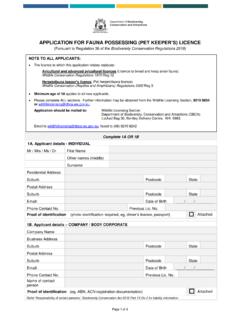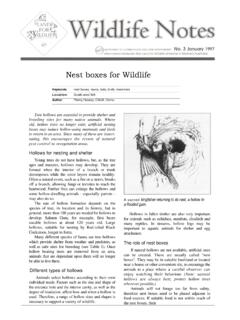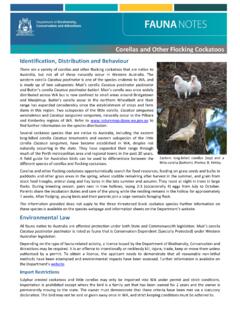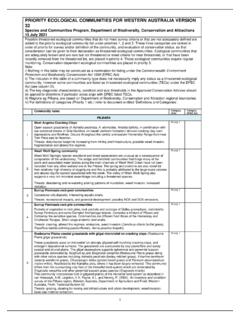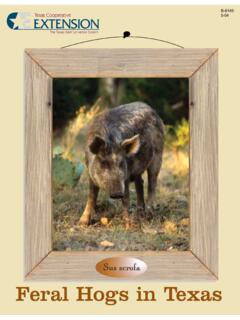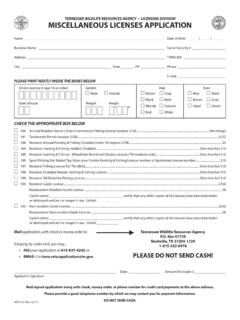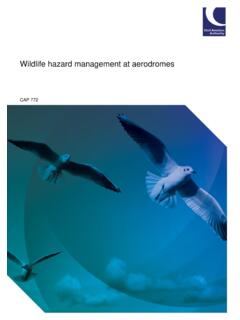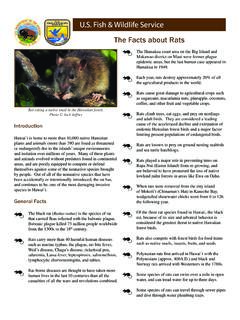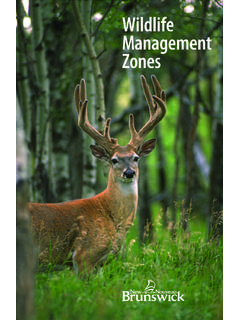Transcription of Reptiles in and around the house - Parks and Wildlife Service
1 Reptiles in and around the house Identification and Distribution Reptiles inhabit every environment in Australia. Common Reptiles found in Western Australian backyards include: Tiger snakes Notechis scutatus occur in southwest WA, and are often seen near water, including rivers, dams, drains and wetlands. Unlike most other Australian elapids, tiger snakes climb well. They can range from grey, olive, brown to black in colour and often have yellow and black cross-bands, but not all have this pattern. Venomous Dugites Pseudonaja affinis occur in southwest WA and Gwarda Pseudonaja nuchalis occur from Perth northwards. They live in a wide variety of habitats including coastal dunes, heathlands, shrublands, woodlands and forests. They are long and slender, with relatively large scales that have a semi-glossy appearance.
2 They can range from brown, olive to grey in colour, and can have irregular black/dark grey spotting, but patterning varies. Venomous Mulga snakes Pseudechis australis occur in a wide variety of habitats, northwards from Perth and Narrogin. They are quite robust, with a broad, deep head and bulbous cheeks. They can range from pale brown, dark olive to reddish-brown in colour, and darker snakes often have two-toned scales with a lighter colour that contrasts with the darker colour to produce a reticulated effect. The belly is cream to salmon-coloured. Venomous There are two subspecies of carpet pythons found in a large variety of habitats in WA: Morelia spilota imbricata occurs in the southwest and Morelia spilota variegata occurs in the Kimberley. They are 1-4m in length, tend to be pale to dark brown with black blotches that sometimes have a paler centre, with a cream belly.
3 They are arboreal in nature and may be found in roof cavities of houses and sheds in search of food. Non-venomous Blue tongues and bobtails (shinglebacks) Tiliqua species. are found throughout WA and are commonly seen in urban and bushland areas. They have large heads and robust bodies, with black-blue tongues. They range in colour from pale to dark brown, olive, grey or black, and usually have pale splotches or streaks. They shelter at night among leaf litter or under large objects on the ground such as rocks and logs. Non-venomous King skinks Egernia kingii and southwestern crevice skinks Egernia napoleonis occur mainly on the coast in the southwest of WA, in dunes, heath, woodlands and limestone and granite outcrops. They are large, heavy-bodied black, olive or brown skinks.
4 King skinks are larger in size that the southwestern crevice skink. Non-venomous Goannas (monitors) Varanus species occur throughout WA. They are dark in colour, varying from grey, olive to brown, and often have a pattern of lighter grey, white or yellow spots, rings, blotches or stripes. Like carpet pythons, some goannas are tree-dwelling and will sometimes enter roof spaces in search of food. Non-venomous Refer to to find further information on these species distributions. Carpet python. Photo: P. Batt/DBCA Bobtail. Photo: K. Page/DBCA Dugite. Photo: R. Lloyd/Fauna Track Heath monitor. Photo: K. Page/DBCA FAUNA NOTES Reptiles in and around the house Behaviour Reptiles are cold-blooded, so they rely on the environment to warm up and cool down. As the temperature rises, particularly during early spring in the southwest, Reptiles begin to move around more and so the number of sightings and encounters with Reptiles also increases.
5 They may also be seen in the winter basking in the sun to warm up or hiding in other warm spots. In hot weather, Reptiles may also be active at night. Reptiles are normally secretive and timid animals, and generally will only attack when threatened or surprised. They like to feel protected and stay hidden and will hide in a variety of places. In more natural environments, they will shelter in burrows, rock crevices, tree hollows and under leaf litter, rocks and logs. In and around house , they may also hide under sheets of wood or tin, concrete slabs, plastic tarps, and piles of bricks, pipes, fire wood and stones, inside sheds and houses, and in wall and roof cavities, aviaries and compost heaps anywhere that is dark and/or warm and where they can find food. Most Reptiles are carnivorous and, depending on the species, they may eat mammals, birds, frogs, other Reptiles , insects, snails and eggs.
6 As top order predators, large Reptiles are good indicators of a healthy environment, so if you happen to see one in your yard, it means there is a healthy balance in the local food chain. Environmental Law All fauna native to Australia are afforded protection under both State and Commonwealth legislation. Depending on the type of fauna-related activity, a licence issued by the Department of Biodiversity, Conservation and Attractions may be required. It is an offence to intentionally or recklessly kill, injure, trade, keep or move them unless authorised by a permit, licence or open season notice. Further information is available on the Department s website. Keeping Reptiles There are strict regulations on keeping native animals as pets in Western Australia. A licence is required to keep or deal in pet Reptiles . Refer to the Department s website for further information on licence requirements and which Reptiles can be kept as pets.
7 Under no circumstances can a reptile that has been found in the wild be kept as a pet. Reptile-Human Interactions If you come across blue-tongue lizards, bobtails and other harmless Reptiles in your house , they can be carefully scooped into a box or bucket using a broom or gently picked up with a towel or protective gloves. Release the lizard either in your backyard (if found in the house ) or neighbouring bushland reserve. If you are unsure, call the Wildcare Helpline on (08) 9474 9055. If you come across a snake in or around your house , do not approach or aggravate it in any way. Presume all snakes are venomous and remember that even non-venomous snakes have sharp teeth and can give a painful bite. Keep children and animals away. Keep an eye on where it is and contact the Wildcare Helpline on (08) 9474 9055 for advice and contact numbers for licenced reptile removers.
8 If you are bitten, call for medical help immediately call 000 for an ambulance or get someone to take you to the nearest hospital emergency room. Remain calm and apply pressure to the area. If possible, try to identify the snake so that the correct anti-venom can be given. Learn about the correct treatment for snake bites using the St John Ambulance first aid fact sheet: If you are in an area where you may encounter a venomous snake, whether it is around your home or in Parks or bushland, consider taking the following precautions: Try to avoid areas with long grass, rushes and lots of undergrowth. Keep a watchful eye on the ground where you are walking or working. Walk and/or cycle on paths only, where you can see the ground. Wear long-trousers and boots/enclosed footwear that preferably cover the ankles if bushwalking or working in bushland and long-grassed areas.
9 FAUNA NOTES Reptiles in and around the house Sick or Injured Reptiles Similar to other Wildlife , Reptiles can carry viruses and bacteria, and as they are wild animals, they may scratch and bite when injured or afraid. Only trained and licenced personnel should handle Reptiles , particularly if they are venomous. If you find an injured or sick reptile, contact the Wildcare Helpline on (08) 9474 9055 for information on registered Wildlife rehabilitators in your area or take it to your closest vet for assessment. Keeping Reptiles Out Snakes are an integral part of the environment and play an important role in Wildlife ecosystems. However, you can discourage snakes and other Reptiles from using your property by making your house and garden less attractive to them. The following measures may help to keep Reptiles out of your house and garden: Keep the garden and sheds tidy and well-maintained, and prune lower branches off of shrubs to remove places for Reptiles to shelter.
10 Keep food scraps/compost in properly covered bins. Block off possible entrances to and access underneath sheds. Block off potential entry points to houses by installing screens on doors and windows and blocking small holes, including those between the roof and ceiling. Fit rubber weather seals under doors to deny access to adult snakes. Remember that snakes can squeeze through surprisingly small gaps. Control rat and mice numbers in and around houses and sheds. Reinforce chicken coops and aviaries to exclude both rodents and large Reptiles by covering them completely with mesh that is small enough (<10mm) to stop them from entering - if mice can get in, so could a snake. Keep chicken coops and aviaries clean and hygienic. Related Information Department webpage: Dealing with snakes Australian Museum webpage: St John Ambulance first aid fact sheet: Snake bite Citation Department of Biodiversity, Conservation and Attractions.
